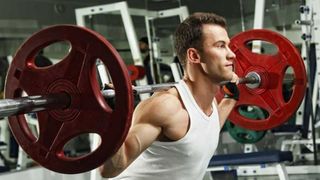How To Powerlift Safely
Physiotherapist Lucy Macdonald explains how to improve your technique for injury prevention

Anyone who hits the gym regularly knows how annoying it can be when an injury gets in the way of training. Lifting very heavy weights, as powerlifters do, often leads to injury – but common powerlifting injuries are usually caused by technique problems that can easily be prevented. I’m going to outline three common injuries and the mistakes that cause them, as well as how to avoid them.
Remember – any pain you have must be fully diagnosed and technique adjustments must only be made under the guidance of a qualified physiotherapist.
Lower back pain
This can range from muscular aches to more serious joint or disc injuries that can cause neurological symptoms such as tingling, numbness and weakness in the legs – it’s particularly important to have these assessed by a physio before continuing training.
Solution When squatting, deadlifting or doing anything that involves bending your hips and knees, your lower back should retain its natural concave curve. This can be achieved by visualising tipping the tailbone upwards behind you, particularly as your hips move closer to the ground. Specific training of the deep abdominal muscles and back extensors can help to maintain this posture – learn how to do this type of back exercise in my article about how to fix back problems.
Shoulder pain
The most common form is ‘impingement syndrome’, which involves damage to a combination of structures such as the long head of the biceps tendon, supraspinatus and the subacromial bursa. Pain can therefore be experienced at the front, top or behind the shoulder as well as being referred to the area of the deltoid muscle in the side of the arm.
Solution Technique can be improved by training the scapular stabilisers that hold the shoulder blade in the correct position and allow the stability muscles of the ball and socket joint of the shoulder – the rotator cuff muscles – to work optimally. Find more of this type of shoulder exercise in my article about how to fix shoulder injuries.
When doing any movements in which the arm is not moved above shoulder level (pushing or pulling), you should avoid moving the shoulder blade forwards. When looking at the alignment of the shoulder from the front, its upper contour should form an upward curve (smiley face) not a downward curve (unhappy face).
Get the Coach Newsletter
Sign up for workout ideas, training advice, reviews of the latest gear and more.
Neck pain
The small intervertebral discs, facet joints, nerves and blood vessels in the neck can become irritated if this part of the spine is not held in the correct position. This can cause neck pain, headaches and symptoms such as pins and needles or pain in the upper back and/or arms.
Solution When doing upper-body or lower-body resistance exercises the neck should be held in neutral – that is, with a very slight concave curve. Most often the chin is lifted away from the body squashing the structures at the top of the back of the neck and stretching structures at the front. This can be corrected by gently tucking the chin in and ‘elongating’ the back of the neck. Find more neck exercises in my article about how to treat neck injuries.

Lucy Macdonald has been a sports physiotherapist since 2004, with experience treating professional and amateur sports people including members of the GB ski and powerlifting teams.
